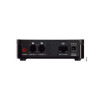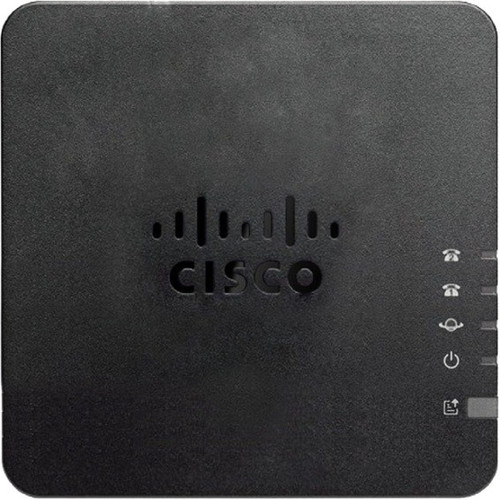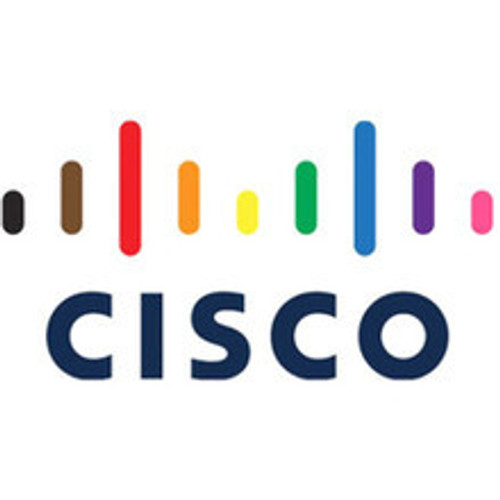Product Description
The Cisco ATA 192 Multiplatform Analog Telephone Adapter turns traditional telephone, fax, and overhead paging communications devices into IP devices for greater cost-effectiveness. Customers can take advantage of IP telephony applications by connecting their analog devices to Cisco analog telephone adapters. The ATA 192 is the preferred solution to address the needs of customers who connect to enterprise networks, small offices, or unified communications as a service from the cloud. It has two standard FXS ports, which can be configured independently as two Session Initiation Protocol (SIP) registrations. It also has two 100BASE-T ports with an integrated high-performance router to extend local network connectivity. With the ATA 192, customers can protect and extend their existing investment in analog systems, as well as smooth their migration to pure voice over IP in a more affordable and reliable way.
Core Features:
- Voice quality: Offers clear, natural-sounding voice quality via advanced preprocessing, high-performance echo cancellation, voice activity detection, and comfort noise generation
- Cloud provisioning: Enables zero-touch provisioning via TR-069 and XML configuration files
- Security: Provides a complete security solution for both media and signaling
- Problem reporting (PRT): Improves serviceability with a dedicated PRT button for problem reporting and log collection
- IPv6: Enables IPv6 dual stack to help with migration to IPv6
| Weight | 0.2 lbs |
|---|---|
| Dimensions | 1.1 × 3.9 × 3.9 in |
| Brand | Cisco |
| Number of Ports | 2 FXS |
Physical dimensions (H×W×D) 3.9 x 3.9 x 1.1 in. (100 × 100 × 28 mm)
Weight (g) 4.7 oz (132.1 g)
Hardware Interface: Two RJ-11 FXS ports, two 10/100 Mbps RJ-45 Ethernet ports,
Button: Reset / Problem Reporting (PRT)
LED indicators: Power, Network, Phone 1, Phone 2, PRT
Wall mountable
Subscriber Line Interface Circuit
(SLIC)
Ring voltage: 40 to 90 Vpk configurable
Ring frequency accuracy: 1%
Ring waveform: Trapezoidal or sinusoidal
Maximum ringer load: 3 Ringer Equivalence Numbers (RENs)
On-hook voltage (tip and ring): -46 to -56V
Off-hook current: 25mA +/- 10%
Terminating impedance: 600 ohm resistive, 900 ohm resistive, or 220 ohm + 820 ohm
120 nF complex impedance
Frequency response: 300 to 3400 Hz
Return loss (600 ohm, 300 to 3400 Hz): up to 26 dB
Idle channel noise: <-65 dBm 0p
Longitudinal balance: 58 dB (typical)
Voice quality Mean Opinion Score (MOS): >4.0
Voice quality jitter: <150 ms
Networking MAC address
IPv4 only
IPv6 only
IPv4/IPv6 dual stack
Session Initiation Protocol (SIP)
Transmission Control Protocol (TCP)
User Datagram Protocol (UDP)
Real Time Protocol (RTP)
Real Time Control Protocol (RTCP)
HTTP
HTTPS
Trivial File Transfer Protocol (TFTP)
Address Resolution Protocol (ARP)
DNS A/AAAA and SRV records
Dynamic Host Configuration Protocol (DHCP) client
Internet Control Message Protocol (ICMP)
Simple Network Time Protocol (SNTP)
Cisco Discovery Protocol
Link Layer Discovery Protocol (LLDP)
Point-to-Point Protocol over Ethernet (PPPoE)
Routing Routing and bridging
Static and dynamic address assignment
Network Address Translation (NAT)
DHCP client reservation
MAC address cloning
Port forwarding
DMZ mode
VPN pass-through: IP Security (IPsec) Encapsulating Security Payload (ESP), Point-to-Point Tunneling
Protocol (PPTP), Layer 2 Tunneling Protocol (L2TP)
Quality of Service (QoS) IEEE 802.1p/Q (QoS and VLAN tagging)
Differentiated Services (DiffServ), Type of Service (ToS)
Telephony Anonymous call and call blocking
Call forwarding: No answer, busy, and all
Call hold and resume
Caller ID blocking
Caller ID generation (name and number): Bellcore, BT, and European Telecommunications Standards
Institute (ETSI)
Caller ID with name and number
Call pickup and group pickup
Call transfer, call return, and call back on busy
Call waiting
Configurable ring frequency
Configurable tones and cadences
Disconnect tone
Distinctive ringing: Calling and called number
Do not disturb
Forced Authorization Code (FAC)/Client Matter Code (CMC)
Flash hook timer
Hook flash event signaling
Hotline and warm line calling
Message Waiting Indicator (MWI) tones
Music on hold
Off-hook warning tone
Polarity control
Redial
Selective and anonymous call rejection
SIP redundancy
Speed dial
Streaming audio server: Up to 4 sessions
Three-way conference calling with local mixing
Tip and ring voltage adjustment setting
Visual Messaging Waiting Indicator (VMWI) using frequency shift keying (FSK)
Network Address Translation (NAT)
Session Traversal Utilities for NAT (STUN)
Audio Codec: G.711 a-law, G.711 μ-law, G.729a, G.729ab, G.726
Codec name assignment
Full-duplex audio
Echo cancellation
Voice activity detection
Silence suppression
Configurable silence threshold
Comfort noise generation
Adaptive jitter buffer
Frame loss concealment
Adjustable audio frames per packet
Call progress tone generation
Impedance and gain adjustment
Dynamic audio payload
Fax Real-time fax over IP via T.38 fax relay (Group 3)
Fax pass-through via G.711 (Group 3)
Fax tone detection and pass-through
Automatic negotiation on transmission rate
Provisioning and management Cloud provisioning (remote configuration)
Web-based administration
Interactive Voice Response (IVR)
Automated provisioning and upgrading via HTTP, HTTPS, and TFTP
TR-069
SSH access
Simple Network Management Protocol (SNMPv3)
Report generation and event logging
Dedicated PRT button
Support for RTP statistics
Syslog (multilevel granularity)
Ping and trace route diagnostics
Configuration management: Backup and restore
Dual image
Security Password-protected system reset to factory default
Password-protected administrator and user access authority
Provisioning, configuration, and authentication
HTTPS with factory-installed client certificate
Advanced Encryption Standard (AES) encryption
SIP over Transport Layer Security (TLS1.1 and TLS1.2)
Secure (encrypted) calling using Secure RTP (sRTP)
Encrypted configuration files
Image authentication
Secure boot
Secure Shell (SSH)
Power DC input voltage: 5V DC at 2.4A maximum
Power consumption: 5W
Switching type (100-240V) automatic
Power adapter: 100-240V and 50-60 Hz (26-34 VA) AC input, with 1.8m cord
Reliability Mean Time Between Failures (MTBF): 300, 000 hours
Operating temperature: 32° to 104°F (0° to 40°C)
Nonoperating temperature: 14° to 140°F (-10° to 60°C)
Humidity: Operating 10% to 90%, noncondensing / nonoperating 10% to 95%, noncondensing
Compliance (regulatory) CE Markings per directives 2014/30/EU and 2014/35/EU
Compliance (safety) UL 60950 Second Edition
CAN/CSA-C22.2 No. 60950 Second Edition
IEC 60950-1:2005 (Second Edition) + A1:2009 + A2:2013 and/or AS/NZS 60950.1:2015
Compliance (EMC) AS/NZS CISPR 32:2015 Class B
CISPR 32: 2015 Class B
EN 55032: 2015 Class B
EN 61000-3-2: 2014 Class A
EN 61000-3-3: 2013
EN 55024:2010+A1: 2015
EN 61000-4-2: 2009
EN 61000-4-3: 2006+A1:2008+A2:2010
EN 61000-4-4: 2012
EN 61000-4-5: 2014
EN 61000-4-6: 2014+AC:2015
EN 61000-4-8: 2010
EN 61000-4-11: 2004
FCC Part 15, Subpart B
ANSI C63.4-2014
ICES-003 Issue 6: 2016
ANSI C63.4-2014
VCCI-TECHNICAL REQUIREMENTS (VCCI-CISPR 32: 2016) /
CISPR 32: 2015 class B
 US Dollars
US Dollars
 United Arab Emirates Dirham
United Arab Emirates Dirham
 Euro
Euro
 British Pound
British Pound
 Turkish Lira
Turkish Lira
 Canadian Dollar
Canadian Dollar
 South African Rand
South African Rand
 Indian Rupee
Indian Rupee
 Brazilian Real
Brazilian Real
 Indonesian Rupiah
Indonesian Rupiah
 Singapore Dollar
Singapore Dollar
 South Korean Won
South Korean Won
 Japanese Yen
Japanese Yen
 Chinese Yuan
Chinese Yuan
 Mexican Peso
Mexican Peso
 Qatari Rial
Qatari Rial
 Saudi Riyal
Saudi Riyal














